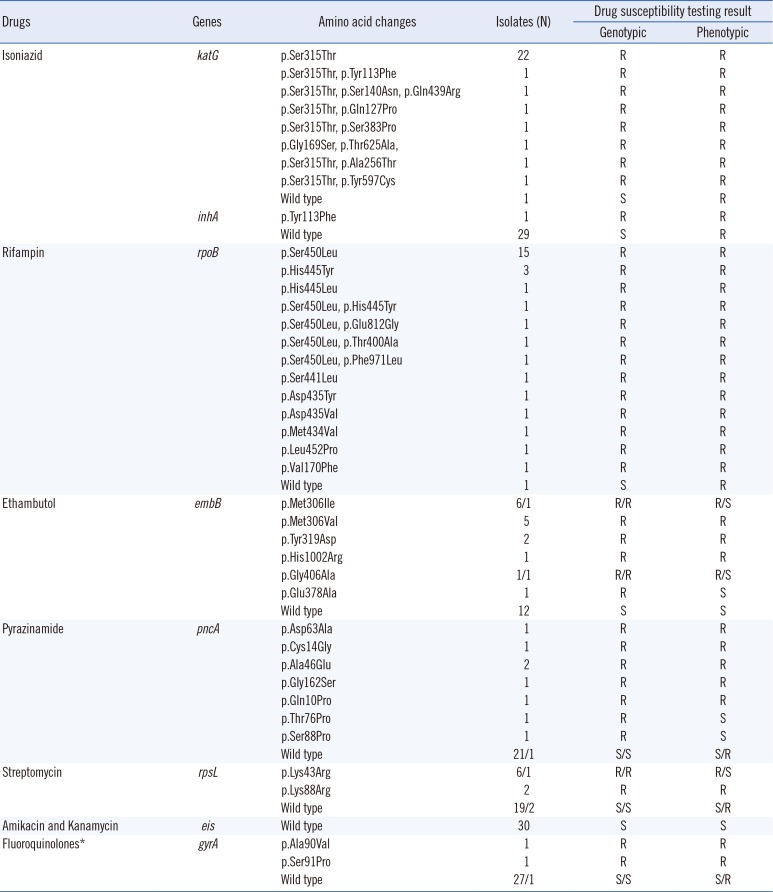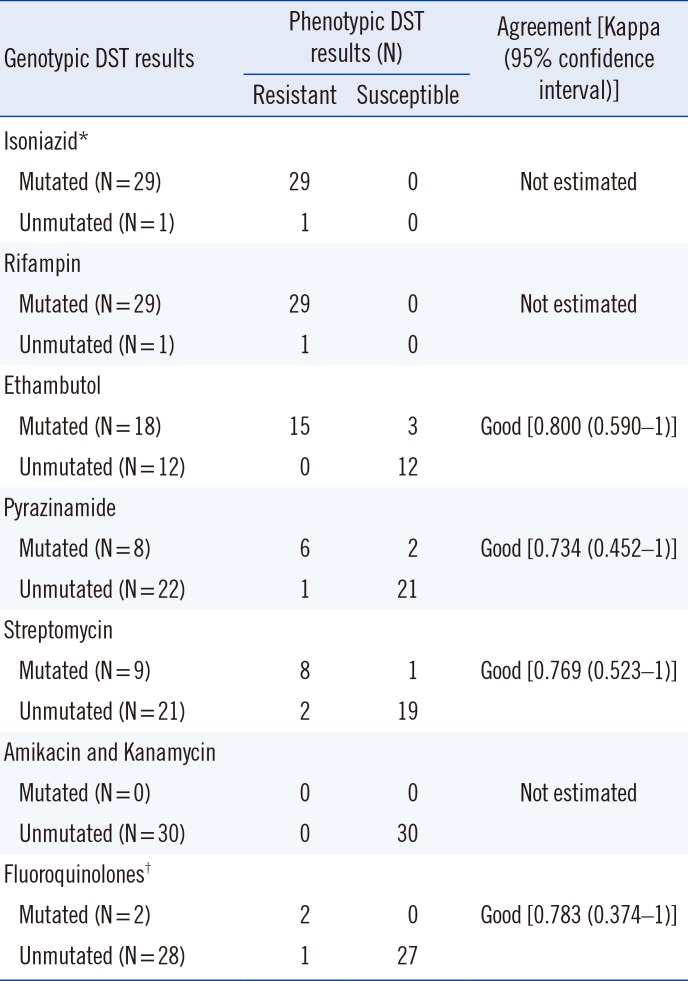1. Rajagopalan S. Tuberculosis in older adults. Clin Geriatr Med. 2016; 32:479–491. PMID:
27394018.
2. Negin J, Abimbola S, Marais BJ. Tuberculosis among older adults--time to take notice. Int J Infect Dis. 2015; 32:135–137. PMID:
25809769.
3. Cegielski JP, Kurbatova E, van der Walt M, Brand J, Ershova J, Tupasi T, et al. Multidrug-resistant tuberculosis treatment outcomes in relation to treatment and initial versus acquired second-line drug resistance. Clin Infect Dis. 2016; 62:418–430. PMID:
26508515.
4. Rodrigues C, Jani J, Shenai S, Thakkar P, Siddiqi S, Mehta A. Drug susceptibility testing of
Mycobacterium tuberculosis against second-line drugs using the Bactec MGIT 960 System. Int J Tuberc Lung Dis. 2008; 12:1449–1455. PMID:
19017456.
5. Meaza A, Kebede A, Yaregal Z, Dagne Z, Moga S, Yenew B, et al. Evaluation of genotype MTBDRplus VER 2.0 line probe assay for the detection of MDR-TB in smear positive and negative sputum samples. BMC Infect Dis. 2017; 17:280. PMID:
28415989.
6. Geleta DA, Megerssa YC, Gudeta AN, Akalu GT, Debele MT, Tulu KD. Xpert MTB/RIF assay for diagnosis of pulmonary tuberculosis in sputum specimens in remote health care facility. BMC Microbiol. 2015; 15:220. PMID:
26483194.
7. Cirillo DM, Miotto P, Tagliani E. Reaching consensus on drug resistance conferring mutations. Int J Mycobacteriol. 2016; 5(S1):S33. PMID:
28043596.
8. Rothberg JM, Hinz W, Rearick TM, Schultz J, Mileski W, Davey M, et al. An integrated semiconductor device enabling non-optical genome sequencing. Nature. 2011; 475:348–352. PMID:
21776081.
9. Colman RE, Anderson J, Lemmer D, Lehmkuhl E, Georghiou SB, Heaton H, et al. Rapid drug susceptibility testing of drug-resistant
Mycobacterium tuberculosis isolates directly from clinical samples by use of amplicon sequencing: a proof-of-concept study. J Clin Microbiol. 2016; 54:2058–2067. PMID:
27225403.
10. Daum LT, Fischer GW, Sromek J, Khubbar M, Hunter P, Gradus MS, et al. Characterization of multi-drug resistant
Mycobacterium tuberculosis from immigrants residing in the USA using ion torrent full-gene sequencing. Epidemiol Infect. 2014; 142:1328–1333. PMID:
24073633.
11. Daum LT, Rodriguez JD, Worthy SA, Ismail NA, Omar SV, Dreyer AW, et al. Next-generation ion torrent sequencing of drug resistance mutations in
Mycobacterium tuberculosis strains. J Clin Microbiol. 2012; 50:3831–3837. PMID:
22972833.
12. Cingolani P, Platts A, Wang le L, Coon M, Nguyen T, Wang L, et al. A program for annotating and predicting the effects of single nucleotide polymorphisms, SnpEff: SNPs in the genome of Drosophila melanogaster strain w1118; iso-2; iso-3. Fly (Austin). 2012; 6:80–92. PMID:
22728672.
13. Sandgren A, Strong M, Muthukrishnan P, Weiner BK, Church GM, Murray MB. Tuberculosis drug resistance mutation database. PLoS Med. 2009; 6:e2. PMID:
19209951.
14. Bland JM, Altman DG. Statistical methods for assessing agreement between two methods of clinical measurement. Lancet. 1986; 1:307–310. PMID:
2868172.
15. Jagielski T, Bakula Z, Roeske K, Kaminski M, Napiorkowska A, Augustynowicz-Kopec E, et al. Mutation profiling for detection of isoniazid resistance in
Mycobacterium tuberculosis clinical isolates. J Antimicrob Chemother. 2015; 70:3214–3221. PMID:
26311839.
16. Kambli P, Ajbani K, Nikam C, Sadani M, Shetty A, Udwadia Z, et al. Correlating
rrs and
eis promoter mutations in clinical isolates of
Mycobacterium tuberculosis with phenotypic susceptibility levels to the second-line injectables. Int J Mycobacteriol. 2016; 5:1–6. PMID:
26927983.
17. Ramirez-Busby SM, Valafar F. Systematic review of mutations in pyrazinamidase associated with pyrazinamide resistance in
Mycobacterium tuberculosis clinical isolates. Antimicrob Agents Chemother. 2015; 59:5267–5277. PMID:
26077261.
18. Kim SY, Park YJ, Kim WI, Lee SH, Ludgerus Chang C, Kang SJ, et al. Molecular analysis of isoniazid resistance in
Mycobacterium tuberculosis isolates recovered from South Korea. Diagn Microbiol Infect Dis. 2003; 47:497–502. PMID:
14596968.
19. Nieto RL, Mehaffy C, Creissen E, Troudt J, Troy A, Bielefeldt-Ohmann H, et al. Virulence of
Mycobacterium tuberculosis after acquisition of isoniazid resistance: individual nature of katG mutants and the possible role of AhpC. PLoS One. 2016; 11:e0166807. PMID:
27893795.
20. Telenti A, Imboden P, Marchesi F, Lowrie D, Cole S, Colston MJ, et al. Detection of rifampicin-resistance mutations in
Mycobacterium tuberculosis. Lancet. 1993; 341:647–650. PMID:
8095569.
21. Sajduda A, Brzostek A, Poplawska M, Augustynowicz-Kopec E, Zwolska Z, Niemann S, et al. Molecular characterization of rifampin- and isoniazid-resistant
Mycobacterium tuberculosis strains isolated in Poland. J Clin Microbiol. 2004; 42:2425–2431. PMID:
15184414.
22. Alcaide F, Pfyffer GE, Telenti A. Role of embB in natural and acquired resistance to ethambutol in mycobacteria. Antimicrob Agents Chemother. 1997; 41:2270–2273. PMID:
9333060.
23. Belanger AE, Besra GS, Ford ME, Mikusova K, Belisle JT, Brennan PJ, et al. The
embAB genes of
Mycobacterium avium encode an arabinosyl transferase involved in cell wall arabinan biosynthesis that is the target for the antimycobacterial drug ethambutol. Proc Natl Acad Sci U S A. 1996; 93:11919–11924. PMID:
8876238.
24. Brossier F, Sougakoff W, Bernard C, Petrou M, Adeyema K, Pham A, et al. Molecular analysis of the
embCAB locus and
embR gene involved in ethambutol resistance in clinical isolates of
Mycobacterium tuberculosis in France. Antimicrob Agents Chemother. 2015; 59:4800–4808. PMID:
26033726.
25. Shi D, Li L, Zhao Y, Jia Q, Li H, Coulter C, et al. Characteristics of
embB mutations in multidrug-resistant
Mycobacterium tuberculosis isolates in Henan, China. J Antimicrob Chemother. 2011; 66:2240–2247. PMID:
21778195.
26. Zhang Z, Wang Y, Pang Y, Kam KM. Ethambutol resistance as determined by broth dilution method correlates better than sequencing results with embB mutations in multidrug-resistant
Mycobacterium tuberculosis isolates. J Clin Microbiol. 2014; 52:638–641. PMID:
24478502.
27. Sengstake S, Bergval IL, Schuitema AR, de Beer JL, Phelan J, de Zwaan R, et al. Pyrazinamide resistance-conferring mutations in
pncA and the transmission of multidrug resistant TB in Georgia. BMC Infect Dis. 2017; 17:491. PMID:
28697808.
28. Mphahlele M, Syre H, Valvatne H, Stavrum R, Mannsaker T, Muthivhi T, et al. Pyrazinamide resistance among South African multidrug-resistant
Mycobacterium tuberculosis isolates. J Clin Microbiol. 2008; 46:3459–3464. PMID:
18753350.
29. Sreevatsan S, Pan X, Stockbauer KE, Williams DL, Kreiswirth BN, Musser JM. Characterization of
rpsL and
rrs mutations in streptomycin-resistant
Mycobacterium tuberculosis isolates from diverse geographic localities. Antimicrob Agents Chemother. 1996; 40:1024–1026. PMID:
8849220.
30. Jagielski T, Ignatowska H, Bakula Z, Dziewit L, Napiorkowska A, Augustynowicz-Kopec E, et al. Screening for streptomycin resistance-conferring mutations in
Mycobacterium tuberculosis clinical isolates from Poland. PLoS One. 2014; 9:e100078. PMID:
24937123.
31. Finken M, Kirschner P, Meier A, Wrede A, Bottger EC. Molecular basis of streptomycin resistance in
Mycobacterium tuberculosis: alterations of the ribosomal protein S12 gene and point mutations within a functional 16S ribosomal RNA pseudoknot. Mol Microbiol. 1993; 9:1239–1246. PMID:
7934937.
32. Nair J, Rouse DA, Bai GH, Morris SL. The
rpsL gene and streptomycin resistance in single and multiple drug-resistant strains of
Mycobacterium tuberculosis. Mol Microbiol. 1993; 10:521–527. PMID:
7968530.
33. Rezaei F, Haeili M, Imani Fooladi A, Azari Garmjan GA, Feizabadi MM. Screening for streptomycin resistance conferring mutations in
Mycobacterium tuberculosis isolates from Iran. J Chemother. 2017; 29:14–18. PMID:
27380108.
34. Aubry A, Pan XS, Fisher LM, Jarlier V, Cambau E.
Mycobacterium tuberculosis DNA gyrase: interaction with quinolones and correlation with antimycobacterial drug activity. Antimicrob Agents Chemother. 2004; 48:1281–1288. PMID:
15047530.
35. Maruri F, Sterling TR, Kaiga AW, Blackman A, van der Heijden YF, Mayer C, et al. A systematic review of gyrase mutations associated with fluoroquinolone-resistant Mycobacterium tuberculosis and a proposed gyrase numbering system. J Antimicrob Chemother. 2012; 67:819–831. PMID:
22279180.
36. Cui Z, Wang J, Lu J, Huang X, Hu Z. Association of mutation patterns in
gyrA/B genes and ofloxacin resistance levels in
Mycobacterium tuberculosis isolates from East China in 2009. BMC Infect Dis. 2011; 11:78. PMID:
21443804.
37. Falzon D, Jaramillo E, Schunemann HJ, Arentz M, Bauer M, Bayona J, et al. WHO guidelines for the programmatic management of drug-resistant tuberculosis: 2011 update. Eur Respir J. 2011; 38:516–528. PMID:
21828024.
38. Niehaus AJ, Mlisana K, Gandhi NR, Mathema B, Brust JC. High prevalence of
inhA promoter mutations among patients with drug-resistant tuberculosis in KwaZulu-Natal, South Africa. PLoS One. 2015; 10:e0135003. PMID:
26332235.
39. Rahman A, Ferdous SS, Ahmed S, Rahman SMM, Uddin MKM, Pholwat S, et al. Pyrazinamide susceptibility and
pncA mutation profiles of
Mycobacterium tuberculosis among multidrug-resistant tuberculosis patients in Bangladesh. Antimicrob Agents Chemother. 2017; 61:e00511–e00517. PMID:
28630193.
40. Sowajassatakul A, Prammananan T, Chaiprasert A, Phunpruch S. Molecular characterization of amikacin, kanamycin and capreomycin resistance in M/XDR-TB strains isolated in Thailand. BMC Microbiol. 2014; 14:165. PMID:
24953243.






 PDF
PDF ePub
ePub Citation
Citation Print
Print


 XML Download
XML Download